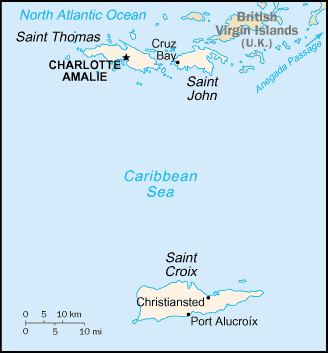The United States Virgin Islands is a group of islands in the Caribbean that is a dependency of the United States. These islands are geographically part of the Virgin Islands.
History
The Virgin Islands were originally settled by the Ciboney, Carib, and Arawaks. The islands were named by Christopher Columbus on his second voyage in 1493. Over the next three hundred years, the islands were held by many European powers, including Spain, England, Holland, France, the Knights of Malta, and Denmark.
The Danish West India Company settled on Saint Thomas in 1672, on Saint John in 1694, and purchased Saint Croix from the French in 1733. The islands became royal Danish colonies in 1754. Sugarcane, produced by slave labor, drove the islands' economy during the 18th and early 19th centuries, until the abolition of slavery by Governor Peter von Scholten on July 3, 1848.
During the submarine warfare phases of the First World War, the USA, fearing that the islands might be seized by Germany as a submarine base, approached Denmark to sell the islands to the USA. On January 17, 1917, the United States bought the Danish West Indies for $25 million and took possession of the islands on March 31. The Danish Crown may have felt pressure to accept the sale, thinking that the USA would seize the islands, if Denmark was invaded by Germany. US citizenship was later granted to the inhabitants of the islands in 1927.
Geography
Main article: Geography of the U.S. Virgin Islands
The U.S. Virgin Islands are located in the Caribbean Sea and the Atlantic Ocean, about 50 miles east of Puerto Rico. The territory consists of four main islands: Saint Thomas, Saint John, Saint Croix, and Water Island, as well as several dozen smaller islands. The combined land area of the islands is roughly twice the size of Washington, D.C..
The U.S. Virgin Islands are known for their white sand beaches, including Magens Bay and Trunk Bay , and strategic harbors, including Charlotte Amalie and Christiansted. Most of the islands, including Saint Thomas, are volcanic in origin and hilly. The highest point is Crown Mountain, Saint Thomas (474m). Saint Croix, the largest of the U.S. Virgin Islands, lies to the south and has a flatter terrain. The National Park Service owns more than half of Saint John, nearly all of Hassel Island, and many acres of coral reef. (See also Virgin Islands National Park, Virgin Islands Coral Reef National Monument , Buck Island Reef National Monument, Christiansted National Historic Site , and Salt River Bay National Historic Park and Ecological Preserve .)
The Virgin Islands lie on the boundary of the North American plate and the Caribbean Plate. Natural hazards include earthquakes and tsunamis.
Politics
Main article: Politics of the U.S. Virgin Islands
The U.S. Virgin Islands are an organized, unincorporated territory of the United States. Although U.S. citizens, Virgin Islanders cannot vote in U.S. Presidential elections.
The main political parties in the U.S. Virgin Islands are the Democratic Party of the Virgin Islands , the Independent Citizen's Movement (ICM) , and the Republican Party of the Virgin Islands . Additional candidates run as independents.
At the national level, the U.S. Virgin Islands elects a delegate to Congress.
At the territorial level, fifteen senators -- seven from the district of Saint Croix, seven from the district of Saint Thomas and Saint John, and one senator at-large who must be a resident of Saint John -- are elected for two-years term to the unicameral Virgin Islands Legislature.
The U.S. Virgin Islands has elected a territorial governor every four years since 1970. Previous governors were appointed by the President of the United States.
The U.S. Virgin Islands has both a District Court and a Superior Court. Judges are appointed by the President and the Governor respectively.
Economy
Main article: Economy of the U.S. Virgin Islands
Tourism is the primary economic activity. The islands normally host 2 million visitors a year, many of whom visit on cruise ships. The manufacturing sector consists of petroleum refining, textile, electronics, rum distilling, pharmaceutical, and watch assembly plants. The agricultural sector is small, with most food being imported. International business and financial services are a small but growing component of the economy. Hovensa, one of the world's largest petroleum refineries, is located on Saint Croix.
The islands are subject to tropical storms and hurricanes. In recent history, substantial damage was caused by Hurricane Hugo in 1989 and Hurricane Marilyn in 1995.

Map of U.S. Virgin Islands
Miscellaneous
Military - note: defense is the responsibility of the US
- See: Virgin Islands and Danish colonization of the Americas, Henry E. Rohlsen International Airport
Last updated: 09-12-2005 02:39:13